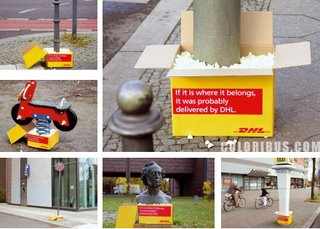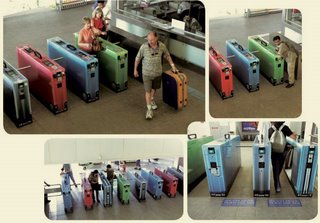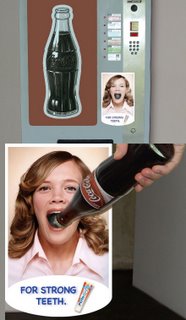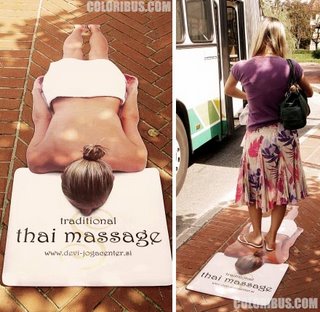Guerilla Marketing – Latest Campaigns using Ambient Media
It is not uncommon for budding prospective Marketers to use jargon before they use marketing. Since I am a potential candidate for the above consideration set, I found it pertinent to get some clarity on the terminologies and their application.
Found some really nice Guerillas at the ad blogs I frequently visit – Coloribus and Twenty Four. Before I talk/put those campaigns, let me attempt to talk a bit about the concept per se.
Guerilla Marketing is a marketing initiative that involves minimum cost for maximum impact. Coined by Jay Conrad Levinson, guerilla marketing is more about matching wits than matching budgets. Wikipedia explains the concept in more detail. It talks about certain principles and communication media, which I have preferred to discount, to avoid restricting my perspective on the same.
Where do Viral Marketing and Ambient Marketing come into picture then, and how are they different from Guerilla Marketing?
Viral Marketing involves a message or a communication that spreads like virus. Something that passes on from one to another quickly, entailing a rapidly extending chain of communicators. A Gmail ID or a MMS by DPS students or a Hotmail account creation are examples of Viral Marketing.
On the other hand, Ambient Marketing is nothing but a part of Guerilla Marketing. It is not a separate entity. However, Ambient Media is something different. It is all media that do not belong to the classic generic group (i.e., TV, print, radio, posters and cinema).
Thus, unconventional media is ambient media and marketing using ambient media would be an element of Guerilla Marketing.
If unconventional media is Ambient, what is Below the line?
Below the line (in the current context) is a form of advertising, which involves direct contact with the customer. It USES less conventional methods to promote products and services. It is not a media but a technique of advertising that does not use the conventional media.
To summarize, Guerilla Marketing is a marketing technique to use minimum cost for maximum impact – it includes other techniques like viral marketing and ambient marketing; ambient media is a form of media which excludes conventional form of media; and below the line is a technique of advertising that uses lesser conventional forms of media
To put things in perspective, in some cases, it might be possible that in a Guerilla Marketing campaign; below the line technique of advertising might be used that involves usage of ambient media! ;-)
Here are a few Guerilla campaigns that are worth analyzing and evaluating. 6 Campaigns in all - click each of them to get a better view of the campaign –

 All campaigns apply Ambient media for their communication. A logic is to be applied in each of them, which I would prefer to leave as food for thought ;). Objective of the used media- high-traffic areas & decent waiting time to ensure exposure (Bus stops/Airports/Check-in counters)
All campaigns apply Ambient media for their communication. A logic is to be applied in each of them, which I would prefer to leave as food for thought ;). Objective of the used media- high-traffic areas & decent waiting time to ensure exposure (Bus stops/Airports/Check-in counters)
Found some really nice Guerillas at the ad blogs I frequently visit – Coloribus and Twenty Four. Before I talk/put those campaigns, let me attempt to talk a bit about the concept per se.
Guerilla Marketing is a marketing initiative that involves minimum cost for maximum impact. Coined by Jay Conrad Levinson, guerilla marketing is more about matching wits than matching budgets. Wikipedia explains the concept in more detail. It talks about certain principles and communication media, which I have preferred to discount, to avoid restricting my perspective on the same.
Where do Viral Marketing and Ambient Marketing come into picture then, and how are they different from Guerilla Marketing?
Viral Marketing involves a message or a communication that spreads like virus. Something that passes on from one to another quickly, entailing a rapidly extending chain of communicators. A Gmail ID or a MMS by DPS students or a Hotmail account creation are examples of Viral Marketing.
On the other hand, Ambient Marketing is nothing but a part of Guerilla Marketing. It is not a separate entity. However, Ambient Media is something different. It is all media that do not belong to the classic generic group (i.e., TV, print, radio, posters and cinema).
Thus, unconventional media is ambient media and marketing using ambient media would be an element of Guerilla Marketing.
If unconventional media is Ambient, what is Below the line?
Below the line (in the current context) is a form of advertising, which involves direct contact with the customer. It USES less conventional methods to promote products and services. It is not a media but a technique of advertising that does not use the conventional media.
To summarize, Guerilla Marketing is a marketing technique to use minimum cost for maximum impact – it includes other techniques like viral marketing and ambient marketing; ambient media is a form of media which excludes conventional form of media; and below the line is a technique of advertising that uses lesser conventional forms of media
To put things in perspective, in some cases, it might be possible that in a Guerilla Marketing campaign; below the line technique of advertising might be used that involves usage of ambient media! ;-)
Here are a few Guerilla campaigns that are worth analyzing and evaluating. 6 Campaigns in all - click each of them to get a better view of the campaign –

 All campaigns apply Ambient media for their communication. A logic is to be applied in each of them, which I would prefer to leave as food for thought ;). Objective of the used media- high-traffic areas & decent waiting time to ensure exposure (Bus stops/Airports/Check-in counters)
All campaigns apply Ambient media for their communication. A logic is to be applied in each of them, which I would prefer to leave as food for thought ;). Objective of the used media- high-traffic areas & decent waiting time to ensure exposure (Bus stops/Airports/Check-in counters)Sources and Details:
DHL; Stretcher by Maltester; Thai Massage; Durex; Baggage;Dent





Comments
Great blog...I am into advertising and it really helps to have basics clear
Thanks
"Above the line" refers to marketing channels involving media placements for which agencies earn a commission: TV, magazines, OOH, newspaper, radio.
"Below the line" typically refers to everything else, or marcom channels involving fees (though online display ads can certainly involved agency commissions): direct mail, PR, telemarketing, SEO/SEM, etc.
The target remembers the marketing material in a more sub conscious way.
It builds trust and is much better and creating long lasting bonds between client and customer.